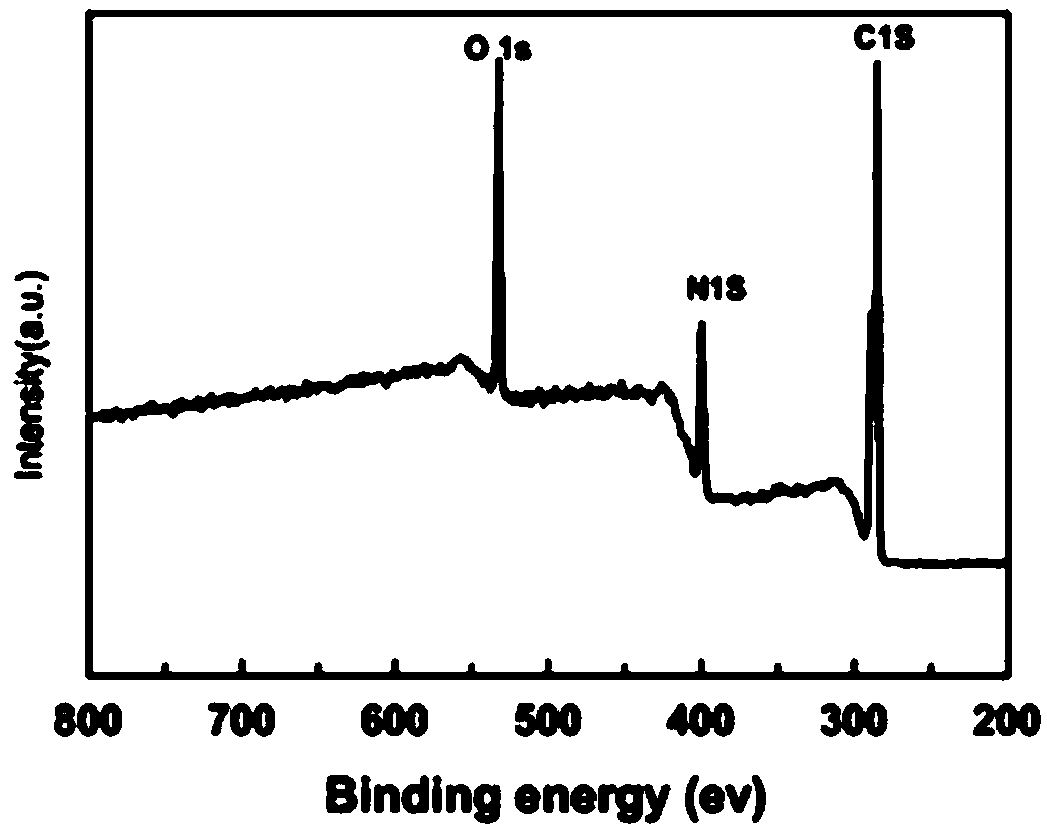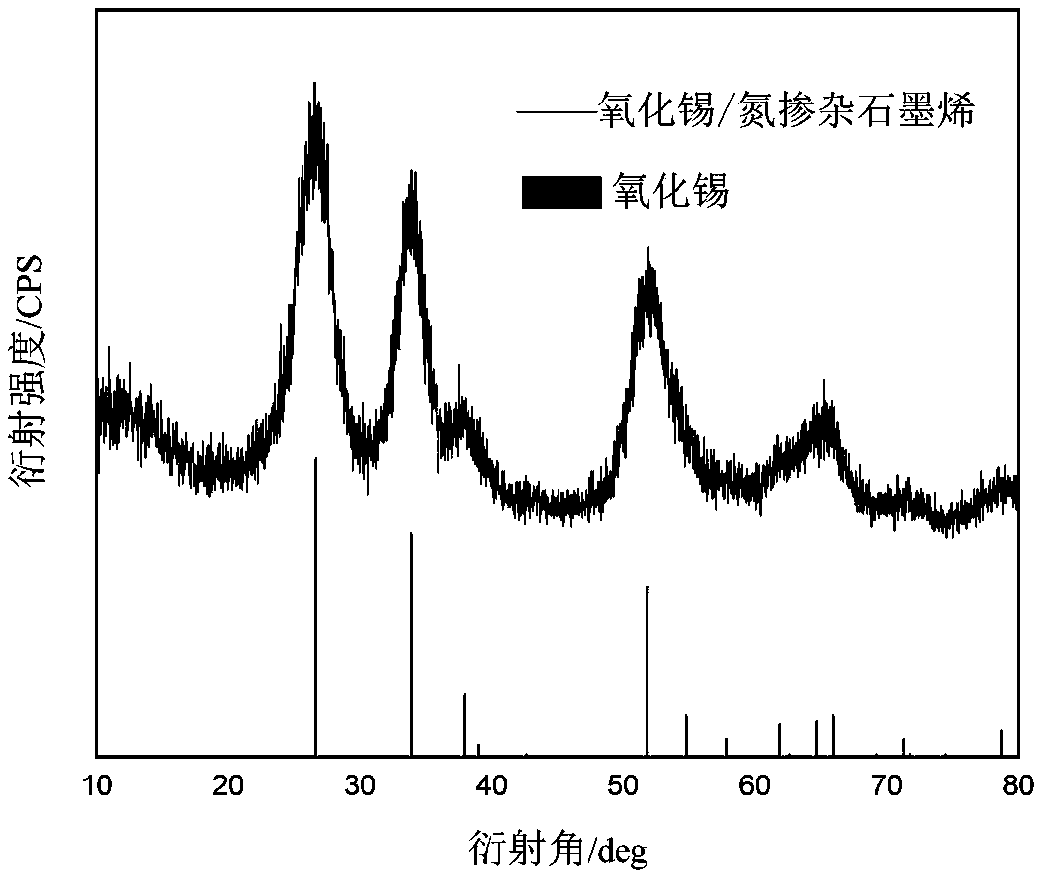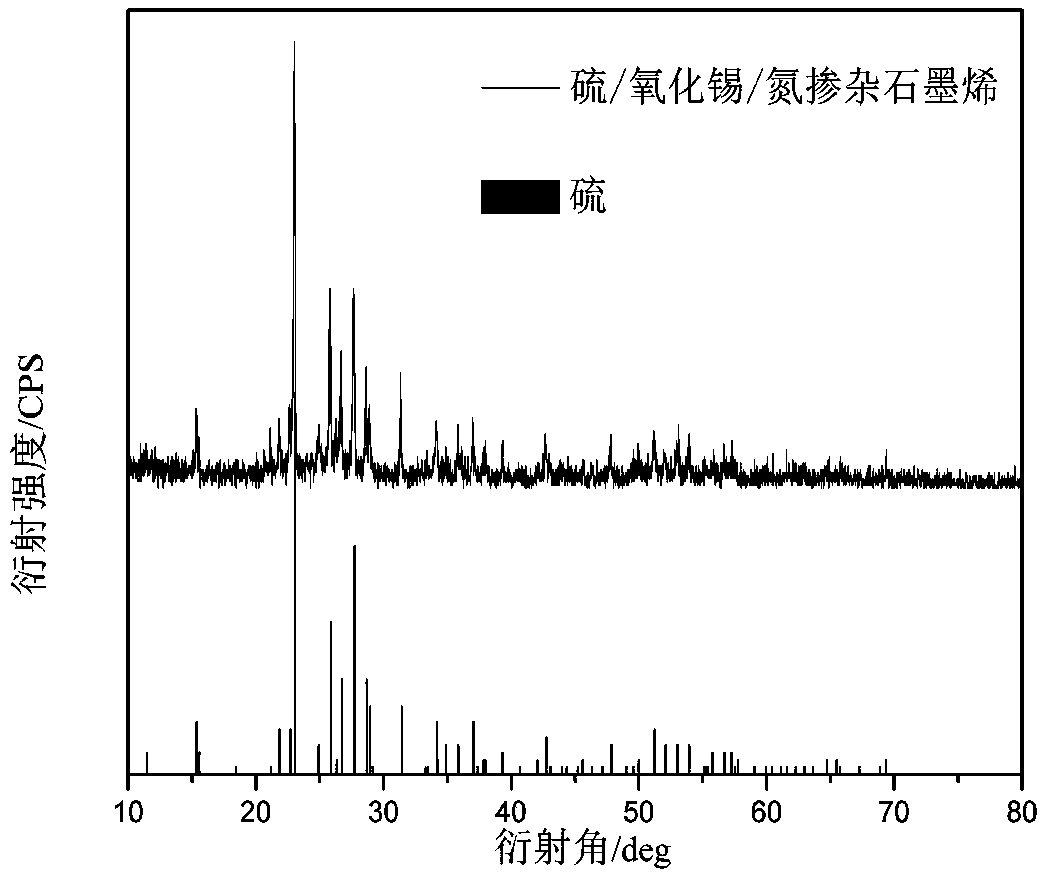Sulfur/tin oxide/graphene battery cathode material, preparation method and lithium sulfur battery
A battery positive electrode, tin oxide technology, applied in the field of nanomaterials, can solve the problems of poor cycle stability and safety performance, short service life of lithium-sulfur batteries, unsuitable for large-scale production, etc., to improve capacity stability and service life, The effect of improving electrical conductivity and improving electrochemical performance
- Summary
- Abstract
- Description
- Claims
- Application Information
AI Technical Summary
Problems solved by technology
Method used
Image
Examples
Embodiment 1
[0044] Preparation of nitrogen-doped graphene: Measure 150ml of 0.8mg / ml graphene oxide aqueous solution and place it in a 250ml beaker, then add 6ml of 50wt% cyanamide aqueous solution, stir evenly, transfer to a three-necked flask, and react at 80°C for 30h , the reaction product was suction filtered, washed with deionized water, frozen, and freeze-dried to obtain nitrogen-doped graphene.
[0045] Preparation of graphene-tin oxide nanocomposite material: take 40mg of nitrogen-doped graphene, add it to 200ml of absolute ethanol for ultrasonic dispersion, then take 0.1mmol of tin tetrachloride (SnCl 4), dissolved in 10ml of absolute ethanol, added to the dispersed nitrogen-doped graphene solution, magnetically stirred until it was uniformly dispersed, then dripped into 5ml of deionized water and transferred the dispersion to the reactor for 100 After reacting at ℃ for 4 hours, the reaction product was cooled naturally, and subjected to suction filtration, washing, freezing, an...
Embodiment 2
[0055] Preparation of nitrogen-doped graphene: Weigh 120 mg of graphene oxide and place it in a 250 ml beaker, add 200 ml of deionized water, ultrasonically disperse evenly, and transfer to a three-necked flask. Then add 5 g of melamine, stir evenly, react at 100° C. for 10 h, filter the reaction product with suction, wash with deionized water, freeze, and freeze-dry to obtain nitrogen-doped graphene.
[0056] Preparation of graphene-tin oxide nanocomposites: Weigh 40mg of nitrogen-doped graphene, ultrasonically disperse it into 160ml of ethylene glycol, and then take 1mmol of SnCl 4 , dissolved in 10ml of ethylene glycol, then added to the dispersed nitrogen-doped graphene solution, magnetically stirred until it was uniformly dispersed, then dropped into 10ml of deionized water and the dispersion was transferred to the reaction kettle for 130 After reacting at ℃ for 0.5h, the reaction product was naturally cooled, and subjected to suction filtration, washing, freezing, and fr...
Embodiment 3
[0059] Preparation of nitrogen-doped graphene: Weigh 120 mg of graphene oxide and place it in a 250 ml conical beaker, add 200 ml of deionized water, and disperse evenly by ultrasonication. Then add 7 g of dicyandiamide, stir evenly, react at 100°C for 16 hours, filter the reaction product with suction, wash with deionized water, freeze, and freeze-dry to obtain nitrogen-doped graphene.
[0060] Preparation of graphene-tin oxide nanocomposites: Weigh 40mg of nitrogen-doped graphene and ultrasonically disperse it in 200ml of carbon tetrachloride, then take 0.4mmol of tin protochloride (SnCl 2 ), dissolved in 10ml of carbon tetrachloride, then added to the dispersed nitrogen-doped graphene solution, magnetically stirred until it was evenly dispersed, then slowly added 8ml of deionized water, and then the dispersion was transferred to the reaction React in a kettle at 130°C for 3 hours, and wait for the reaction product to cool naturally, and then carry out suction filtration, wa...
PUM
| Property | Measurement | Unit |
|---|---|---|
| particle size | aaaaa | aaaaa |
Abstract
Description
Claims
Application Information
 Login to View More
Login to View More - R&D
- Intellectual Property
- Life Sciences
- Materials
- Tech Scout
- Unparalleled Data Quality
- Higher Quality Content
- 60% Fewer Hallucinations
Browse by: Latest US Patents, China's latest patents, Technical Efficacy Thesaurus, Application Domain, Technology Topic, Popular Technical Reports.
© 2025 PatSnap. All rights reserved.Legal|Privacy policy|Modern Slavery Act Transparency Statement|Sitemap|About US| Contact US: help@patsnap.com



